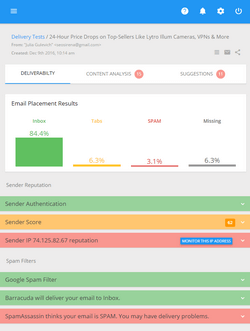8 Tips to Minimize Spam Complaints
Minimizing spam complaints is closely related to best email marketing practices and starts with the method of collecting email addresses. You should remember that nowadays sending unsolicited emails will only hurt you. To get the lowest complaint rates, you need to either use a confirmed opt-in method, or properly manage your single opt-in list. If you send to a solid permission-based list but still find that your spam complaints rate is higher than the optimal rate and/or is rising, consider the following:
- Use a recognizable sender name. Often people only scan the From field or Subject line or both to decide which messages to read and which to delete or report as spam. Use a sender name that’s simple, easily recognized, and expected by the subscribers. Make sure that your From email address is recognized as well because some email applications such as AOL display only the sender email address, not the name.
- Brand your subject lines. A message with a vague Subject line like "super offer for you!!!" will absolutely be reported as spam. You can make your email recognizable by including your company or newsletter name in brackets at the beginning of your subject lines, for example "[G-Lock Software]: New exclusive HTML email templates are available".
- Include the unsubscribe instructions at the top of the email. Some recipients may not scroll to the bottom of the message to find the unsubscribe link but may use the “Report Spam” button as an unsubscribe method. For this reason, consider including your unsubscribe instructions at the top of the email in addition to the footer.
- Ask the recipients to whitelist your domain. This will prevent a user-based filter from flagging your message as spam and either moving it to the spam folder or inserting “[SPAM]” to the message Subject. You can include the instructions on whitelisting your domain or email address in the Email Admin Centre area.
- Avoid spammy looking content. Try not to use garish, bold fonts; large, red letters, and the like. A message with a clean, readable design is not likely to be taken for spam.
- Don’t send too often. If the recipients used to receive your newsletter once a week or month, don’t suddenly start emailing every other day.
- Don’t send unexpected emails. Respect the subscriber’s preferences. If the subscriber opted in to receive your “Tips & News” newsletter, don’t send them e-commerce and promotion messages, unless they clearly requested them.
- Remind the recipient about subscription. Many subscribers receive dozens of commercial email messages every day and they may forget they signed up for your newsletter. It’s reasonable to add to your Email Admin Center the information about the user’s subscription: subscriber’s email address, opt-in date, and newsletter he/she subscribed to.
Spam complaints are an important aspect of email marketing that can’t be ignored. Multiple spam complaints get your emails filtered or blocked. If you don’t deal with complaints and don’t optimize your email marketing practices, with time spam complaints will lead to decreasing open and click-through rates.
Table of contents | Page list for this chapter | Next page

